|
| Assemblyman’s crusade for a new Richmond-San Rafael Bridge: All he needs is $8 billion
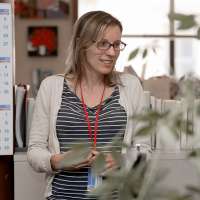
Rachel Swan
Jan. 6, 2020 Updated: Jan. 6, 2020 4 a.m.
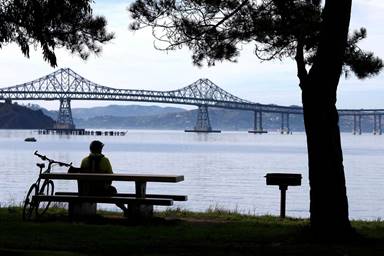
Bicyclist David Bullen takes in the view of the crumbling bridge from Point Molate Beach Park in Richmond. Photo: Photos by Paul Chinn / The Chronicle
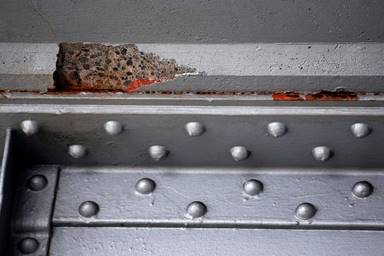
Above: Exposed and broken concrete on the underside of the Richmond-San Rafael Bridge underscores the decay. Photo: Paul Chinn / The Chronicle
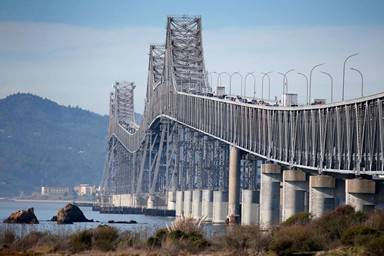
Assemblyman Marc Levine, D-San Rafael, wants to rebuild the Richmond-San Rafael Bridge. Photo: Paul Chinn / The Chronicle
Since the day, early in February, when it unleashed chunks of concrete onto a white Mercedes, the Richmond-San Rafael Bridge has drawn all manner of colorful descriptions. It’s also had 31 joints repaired on the westbound upper deck and opened a popular bicycle path while carrying 82,000 motorists each day.
Still, one assemblyman is crusading for a new, better structure. All he needs is $8 billion.
“If the bridge is going to last another 10 or 20 years, that’s great,” said Assemblyman Marc Levine, D-San Rafael. “But we should be planning for what the next span will look like.”
Although state and regional transportation agencies have sunk more than a billion dollars into maintenance — which includes a new road deck, piers and a trestle at the San Rafael approach — the bridge wouldn’t survive a major disaster, Levine noted. It’s had enough seismic retrofits to remain standing and not cause any deaths during the next big earthquake, but it wouldn’t function afterward.
“And we don’t even have a drawing on a shelf as to what the next bridge should look like,” Levine said.
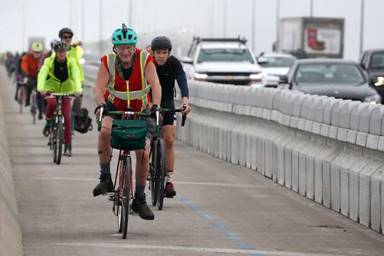
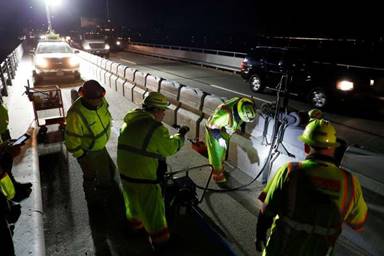
He first pitched the idea of a new structure in April, when pieces of concrete fell from the bridge’s upper deck for the second time in two months. By that point Levine had already been meeting Caltrans officials to discuss the upkeep and lifespan of the bridge deck, which was last overhauled during a major rehab project from 2001 to 2005.
Caltrans recently began a deck analysis and load-rating study to determine whether it’s time to develop a new structure. Agency staff estimated it could come to $8.2 billion, said Caltrans spokesman Bart Ney.
In November, Levine started a website to provide constituents with regular updates on repairs of the 64-year-old crossing, which is scheduled to get a paint job and 30 new joints on the lower deck next year. He’s also seeking suggestions on bus rapid transit, bike and pedestrian paths, and rail — or, possibly, more vehicle lanes. So far, he’s received more than 500 letters and comments from commuters in all corners of the region: Marin, Sonoma, Davis, the Peninsula and the inner Bay Area.
“It’s a remarkably old-looking structure — almost like something built during World War II by the Army Corps of Engineers, instead of in 1956,” said El Sobrante resident Greg Stevens. He crosses the bridge at 5:30 a.m. on weekdays to teach Spanish at Redwood High School in Larkspur.
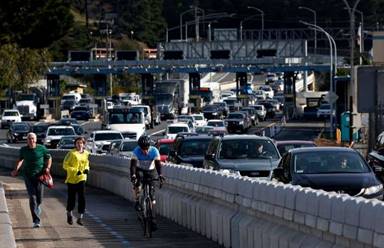
Traffic funnels into two westbound lanes after passing through the toll plaza and past a recently opened bicycle and pedestrian path on the Richmond-San Rafael Bridge.
Photo: Paul Chinn / The Chronicle
Stevens is neutral about a new bridge, but he would like to see significant changes in the current one — namely, removal of the new bike path to add a third lane for car traffic on top. He’d also support other dream projects that would make his commute less hellish, like a BART extension through the North Bay to make a full loop back to Richmond. One advantage of a new span is that it could include imaginative elements, such as bike lanes or rail tracks.
Many commuters have a love-hate relationship with the span, known for its web of metal trussing and undulating roadway — partly to make room for shipping channels, but also to cut costs by removing steel from the design. In a 1953 interview, famed architect Frank Lloyd Wright called the bridge — which was then under construction — “an ignorant violation of good sense and taste.” For decades it’s been the ungainly cousin of the more elegant Golden Gate Bridge, which is known internationally for engineering beauty.
At the same time, motorists rely on this east-west connection to get from homes in Contra Costa to jobs in Marin and San Rafael, where housing is expensive and sparse.
“The high cost of living has forced more than 25% of the public schools workforce to live outside of the county and face long commute times,” Marin County Schools Superintendent Mary Jane Burke and Tamalpais Union High School District Superintendent Tara Taupier wrote in a June letter to Levine. They joined Stevens’ call for a traffic lane on the upper deck to replace the bike path.
Heavy traffic and freight from trucks have strained and battered the bridge. That constant pummeling, combined with the briny salt air of the bay, causes joints to shrink or expand and allows concrete to pry loose. Next year, Caltrans and the regional Metropolitan Transportation Commission will pour $129 million into fixes.
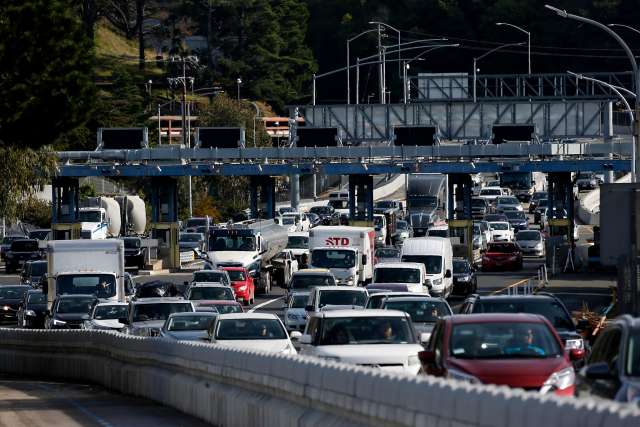
Traffic funnels into two westbound lanes after passing through the toll plaza on the bridge.
Photo: Paul Chinn / The Chronicle
Yet many advocates and policymakers question whether a new a bridge is a wise investment, given all the other transportation needs in the Bay Area. Levine has not presented a funding plan; nor has he taken a stance on the Faster Bay Area sales tax measure, which could bolster big projects like this one, should it pass in November. Officials at the Metropolitan Transportation Commission estimate that motorists would have to pay a $6 toll hike on all the region’s bridges to raise enough money for a new one. A $6 increase, combined with other scheduled hikes, would push the cost of crossing the Bay Bridge to $15 in 2025. Drivers would pay $14 to cross the existing Richmond-San Rafael Bridge.
The North Bay is ripe for infrastructure improvement, but it also has needs that seem more urgent than a new Richmond-San Rafael Bridge, said Stuart Cohen, a transportation consultant who is involved in the Faster Bay Area campaign. Among them is Highway 37, a crumbling road atop a levy that sometimes closes down during the winter because of flooding. It may need a new viaduct or embankment to stave off rising sea levels, which could cost $5 billion.
Some transit advocates view Levine’s push for a new bridge as a form of old-school bravado. A few compared it to a recent appeal by Sen. Dianne Feinstein and East Bay Rep. Mark DeSaulnier, who want a “Southern Crossing” for cars and transit.
Politicians often fixate on big capital projects that allow them to stick a gold shovel in the ground, said Bob Allen, director of policy and advocacy campaigns for the nonprofit group Urban Habitat. In reality, Allen argued, it’s the less glamorous solutions — increased bus service, transit-only lanes and better connections — that a make a difference in people’s lives. Another possibility: investing in e-bikes to transport more people along the bike lane to jobs in Marin and San Rafael, Cohen said.
Levine deflected concerns about the cost of a bridge and accused naysayers of “trying to throw cold water on something that’s not their own pet project.”
He’s aware that such a monumental project won’t happen immediately. But he’s adamant that the Bay Area start planning now, considering the glacial pace of transportation projects: It took 25 years to rebuild the east span of the Bay Bridge after the Loma Prieta earthquake.
“Knowing that there is going to be no functioning bridge after a disaster is enough reason for me to want a plan on the shelf, ready to go,” he said. “As far as what it looks like — I’ll leave that up to the many creative dreamers in the Bay Area.”
Rachel Swan is a San Francisco Chronicle staff writer. Email: rswan@sfchronicle.com Twitter: @rachelswan |

